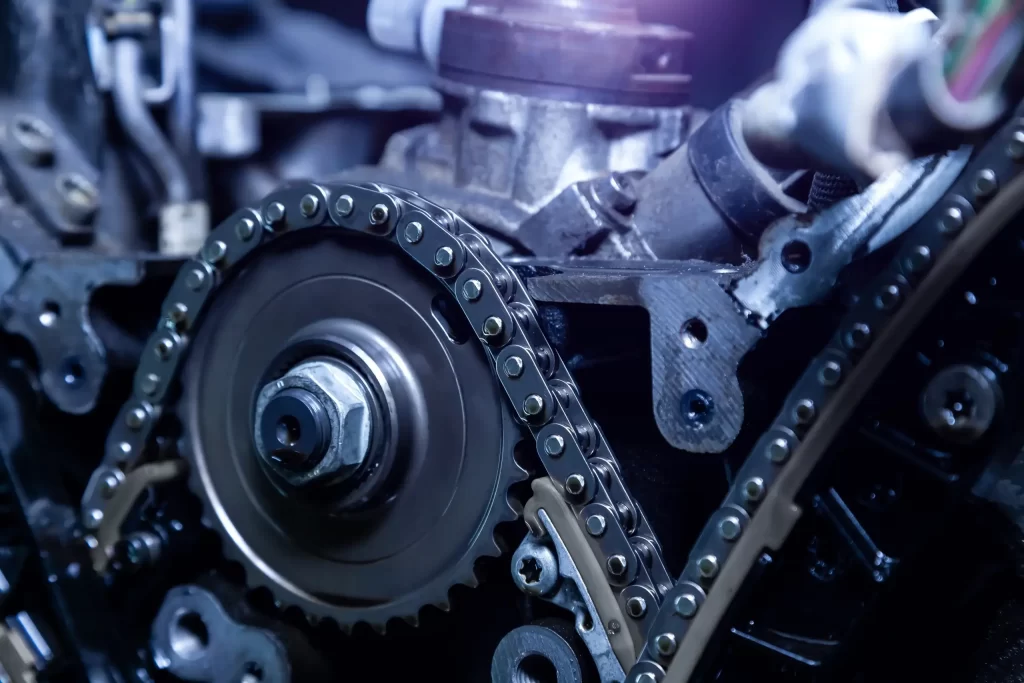If you are on the hunt for a new car, you might be wondering whether a timing belt or a timing chain suits your needs. In general, this decision is not as crucial as choosing the engine and fuel type, or even the body color.
Is it worth it to take time and learn about their differences? In this article we are going to address both timing systems. Here we’ll tackle each one’s cons and pros, so that you can reach your own conclussions and decided which syncronization system is more interesting and better suited to your needs.
What are the different types of timing systems?

We always talk about timing belts and timing chains, but those are not the only timing systems on the market. There are three ways o transmit movement to the camshaft:
- Timing belt: most extended system nowadays. The majority of engines we know use a timing belt. This elastic belt is the most affordable option out there, and lowers the engine production costs. There are two different types of timing belt: the ‘wet belt’ and the ‘dry belt’. The wet belt is sumerged in oil, which severely affects its durability.
- Timing chain: it is a metalic belt which which is stronger and more durable than a timing belt, although they function in much the same way. The timing chain’s principal quality is that, at least on paper, it will not need to be replaced during the car’s lifespan.
- Cascade gear system: this one is the most reliable system out there. We can find this timing system in older engines and motors for large-displacement vehicles. Some modern allroad vehicles also make use of this timing system, since timing chains would have their lifetime greatly reduced due to dust and erosion exposure.
Lastly, there are vehicles that have no timing system. We are talking about electric cars, automobiles that run on an hydrogen cell and even Wankel-type combustion engines.
Which timing system is better? Chain vs. Belt
Now that we know how many timing systems there are, it is time to compare them:
Which system is cheaper to replace?
Here’s the dilemma: a timing belt does need some maintenance. The rubber this engine component is made of will eventually degrade with use. Therefore, we need to replace this piece at a certain mileage, which will be indicated by the manufacturer.
A timing chain, on the other hand, does not need to be replaced as frequently. In fact, the great majority of cars with this timing system will be sent to the scrapyard with the original timing chain they had the day they left the manufacturing plant..
However, the timing belt wins this round. Timing belt repairs are very affordable, even their entire replacement is less costly. If you are ever in the position of needing to change a timing chain, the mechanic will need to disassemble more engines pieces, which translates into more man-hours and a substancial bill from the repair shop.
Which one lasts longer?

Punto para la cadena, como no podía ser de otra forma. La cadena de distribución está pensada para que no tenga que ser sustituida nunca. Eso sí, eso no significa que no se degrade o que no sea recomendable hacer un reemplazo en algunos casos.
Points for the timing chain! A car’s chain is designed to last forever. However, that does not mean it cannot degrade, or that replacing it is not advisable in some cases.
With a few exceptions, almost all manufacturers state in their maintenance books that their cars’ timing chains are ‘lifetime’ : that means, this engine piece will outlast the vehicle itself. However, the car needs a correct general maintenance throughout the years for this promise to actually happen.
Regarding timing belts: their durability is also outstanding. Thanks to technological advances, they are now made with new materials that can last 100,000 or even 150,000 kilometers (60,000 or even 90,000 miles).
Which one is more resistant to external agents?

Apart from sheer mileage, there are many factors that can degrade an automobile and its components. Wind, humidity, dust or sand can affect a vehicles performance with the passage of time.
Although it is true that all these variables can erode a timing chain, the timing belt is specially vulnerable to external factors. The only substance that could seriously affect a timing chain in a short time would be a poor quality engine oil.
The timing chain, being encased inside the engine, is practically invulnerable to any external agent. On the other hand, the timing belt is susceptible of being damaged by oil and coolant leaks, despite being in a different enclosure and isolated from the engine crankcase. Moreover, the timing belt could also start to malfunction if the service belt (i.e. the auxiliary belt of the alternator) broke.
Which one gives a warning before breaking?

Forewarned is forearmed… Unfortunately, the timing belt is a treacherous engine component, for it does not give advance notice before tearing off. When a timing chain does stretch, the engine syncronization will falter, giving a fair warning to the driver that something is not right.
If an engine with timing chain cannot start when cold, or jerks at idle speed, you are due to change either the timing chain or the tensor. There are also other symptoms that give away an inminent timing chain failure.
As we were saying, a timing belt is not that predictable. A driver with acute hearing might notice something is wrong, but this is not common. A faulty metal timing chain is far more noisy. A belt, usually made of kevlar and similar materials, is not stiff enough to clank.
Which one would leave me in the lurch in case of failure?

It is widely known that if a timing belt or a timing chain break, we can say goodbye to our engine. However, both timing systems work with other components. This is what we are refering to. What happens if the auxliliary belt fails? Faced with a breakdown of this caliber, you are more likely to return home if you have a car with a timing belt.
Almost all engines with a timing belt have a water pump attached. Engines with a timing chain have it separate. If we are left without the auxiliary belt in a timing chain system, our engine will have problems to regulate its temperature, and ultimately shut down.
If our auxiliary belt breaks off in a timing belt system, it is possible to keep driving a few miles before the overheating signal pops up. Why is that? Because the water pump will keep running. Also, in this second scenario, if the car’s battery is in good condition, we will be able to power the car’s electronic systems until we reach our destination.
Which one withstands engine power?

High-performance engines tend to use timing chains, so this is a fairly easy answer. A timing chain holds power and torque much better, so it is a safe bet for larger engines. It is, in fact, uncommon to find big motor blocks that use a belt to syncronize its valves.
Any conclussions?
We could say that both timing systems are evenly matched. A chain can save maintenance costs, although we will need to pamper it to avoid damaging it. Timing chains can withstand temperature changes and extreme weather. They also give a fair warning at the slightest failure.
A timing belt, on the other hand, is affordable, far less noisy, and will not be very fussy if we keep up with the car maintenance. Since it is attached to the water pump, it will give is a precious few miles to drive to a repair shop in case the auxiliary belt breaks.
That is all! If you have made up your mind about what timing system you would prefer for your car, take a look at the vehicle lists we have in our website. That way, you will find out which cars have a timing belt and which ones have a timing chain.
